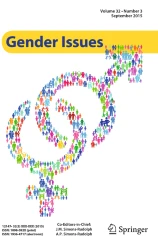Connect with the Libraries
Have an idea for Subject of the Month?

Selector: Luke Kurfess
girlhood was something
i passed through
it was not a mistake
or a final destination.
-Poem By Ren Strawn
See the full piece at this link with the collage.
Artist's page: renstrawnart.com
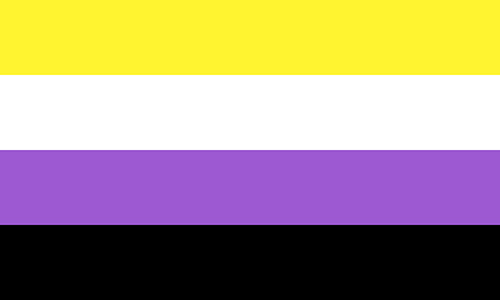
Nonbinary Pride Flag
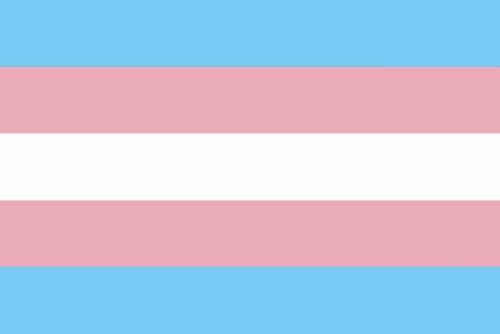
Transgender Pride Flag

Demigender Pride Flag

Demigirl Pride Flag

Demiboy Pride Flag

Pangender Pride Flag
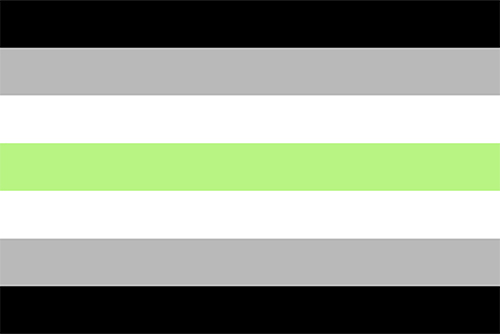
Agender Pride Flag

Genderqueer Pride Flag
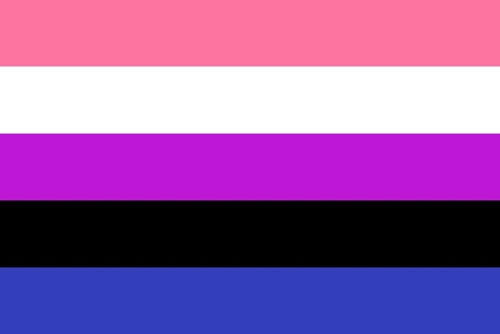
Genderfluid Pride Flag

Bigender Pride Flag
Pride and the Origins of Different Flags
Pride in one's identity is important in all parts of the LGBTQIA+ community. The flags above are only a handful of examples of the tangible representations of gender identities and the pride, comfort, and belonging people find in them. For more background on their uses, origins, and meanings, explore some of the links below:
This featured article goes into the details of the origins of the modern pride flag, and LGBTQIA+ symbology in general.
A short article about the different iterations of the pride flag, and examples of other pride flags in use today.
This article explains the meaning and history behind many different pride flags, including some of those that represent gender identities.
Introducing Gender Identity
What *is* gender? While it might seem like a simple question, gender can be understood in many different ways. Gender can refer to a role that is "performed", a personal experience, and/or an identity. Our understanding of gender is not constant, has changed over time, and varies among individuals and groups. Gender identity, pronouns, and gender expression are distinct from one another, yet often get lumped together because for many people they intersect or match, but certainly not all.
Pronouns refers to just that: how people refer to others when not using their name. If can often correlate with gender, but not always. Using the correct pronouns is a sign of respect, so it's important to know and normal to politely ask for a person's pronouns.
Expression is the outward appearance of gender. It might have nothing to do with someone's internal gender identity, but it's often how people signify their gender to others, knowingly or not. We generally associate dresses or skirts with women, for example, or business suits with men. This is an association we make because of cultural norms, however, and the outward expression of gender comes in many forms.
Gender identity refers to an internal sense of self or gender, and has many nuances. It could be man, woman, neither, some mix of the two, or something else entirely. We have many labels for these concepts, and while labels can help people understand themselves and others understand their experiences, even those using the same labels often have unique experiences of gender. Labels, too, can be both limiting and freeing.
Historically, gender has taken on many forms and meanings. Today and in the past, gender variance can be found in the māhū of Hawai'i, two-spirit people in native cultures, Femminielli in traditional Neapolitan culture, hijra in India, and many other examples across the world. A binary concept of gender was constructed in certain cultures, but the reality of human experiences has always been much more diverse.
Explore some of the links below for more resources on these concepts.
-
From NPR: A Guide To Gender Identity TermsThis brief glossary of terms explains the concept of gender identity and related ideas, such as how pronouns, gender identity, and gender expression are related to and differentiate from each other.
-
Encyclopedia Brittanica Online: Gender IdentityAn encyclopedia entry on the term "gender identity" and related resources, including a video on the differences between sex and gender.
-
Gender, Sexuality, and Women's Studies GuideAnother Libguide from Wayne State University that includes some really helpful information and resources on gender!
-
Wayne PrideWayne State's home for everything related to LGBTQ resources, support, information, and pride.
-
Changing Pronouns at Wayne StateA guide to changing your pronouns within Wayne State's systems.
-
Map of Gender Neutral RestroomsMaps of all gender neutral restrooms on campus, by building.
-
Trans Resource HubAll things dedicated to supporting trans people.
List of University and Community Organizations:
-
All Wayne State LGBTQIA+ Student OrgsCheck out this link to see all current LGBTQIA+ Wayne State student orgs!
-
Wayne State Queer Faculty and Staff OrgAn organization for Wayne's queer faculty and staff to come together and create programming and safe spaces for faculty and staff on campus.
-
List of Resources from Wayne State PrideThis page from Wayne's hub for everything related to pride connects users to many more resources than is listed here.
-
Future Librarians for Inclusivity and DiversityA Wayne State student group open to everyone at Wayne State, with a focus on understanding issues of equity and celebrating diversity of identity within the information science field.
-
LGBT DetroitFrom their website: "LGBT Detroit commits to furthering its mission, increasing the prominence and visibility of Detroit’s LGBT culture, and building a strong, healthy and vibrant community, with a focus on youth and young adult development, sexual orientation and gender identity education and advocacy, and emotional and physical well-being."
-
Jim Toy Community Center (Ann Arbor)From their website: "The Jim Toy Community Center is a resource center that exists to provide information, education, social events, and advocacy by and for the Queer and Ally community in the Washtenaw County area. JTCC welcomes all who support its mission to participate in its activities."
-
Affirmations (Ferndale)From their website: "Affirmations LGBTQ+ Community Center was founded in 1989 with a mission to provide a welcoming space where people of all sexual orientations, gender identities and expressions, and cultures can find support and unconditional acceptance, and where they can learn, grow, socialize and feel safe."
-
For LGBTQ+ Youth, The Trevor Project (24/7 Support)An organization focused on helping people of the LGBTQIA+ community aged 13-24. They provide 24/7 counselor and crisis services, and a provide a forum/community space online in TrevorSpace.
eBooks available by request through the Michigan eLibrary (MeL), Fiction and Nonfiction
Representations of Gender Identity in Media
-
JoylandThe youngest son in a traditional Pakistani family takes a job as a backup dancer in a Bollywood-style burlesque, and he quickly becomes infatuated with the strong-willed trans woman who runs the show.
-
A Year in TransitionA Year in Transition follows a 20-year-old Arab-American transgender man in his first year of transition as he comes out, begins taking hormones, has top surgery, and finds his own place in the trans community. The film is based out of Ypsilanti, MI and includes other transmasculine people in the Metro Detroit area.
-
XXYFor just about everybody, adolescence means having to confront a number of choices and life decisions, but rarely any as monumental as the one facing 15 year-old Alex (Ines Efron), who was born an intersex child.
Theories of Gender: Crash Course Sociology #33
A look into three theories of gender: structural functionalist, symbolic interactionist, and conflict theory. Consider the question: Why does gender matter to us?
A few years ago, Jay realised she was transgender and, with that, realised that transgender people are misunderstood on many levels. In her talk she sets out to explain what it feels like to be transgender, so that people can understand it better and become more understanding and accepting. This talk was given at a TEDx event using the TED conference format but independently organized by a local community. Learn more at https://www.ted.com/tedx
"Boys Will be Bugs" by the band Cavetown.
"Cameron" by Jillette Johnson.
"Rebel Rebel" by David Bowie.
"Way Home" by Shawnee Kish
"The Village" by Wrabel
The Digital Transgender Archive
The Digital Transgender Archive is an online hub and repository for all things related to transgender history. As an archive, it contains digitized and born-digital materials, while also maintaining information on archival holdings relating to transgender history throughout the world. The project is a collaborative undertaking by many universities, nonprofit organizations, public libraries, and private collections to increase access to transgender history. The project, while digital, is based in Boston, Massachusetts at Northeastern University. Access the archive below.
Experiences of Gender Represented in Art in the Exhibit "Becoming: Illuminating Experiences"
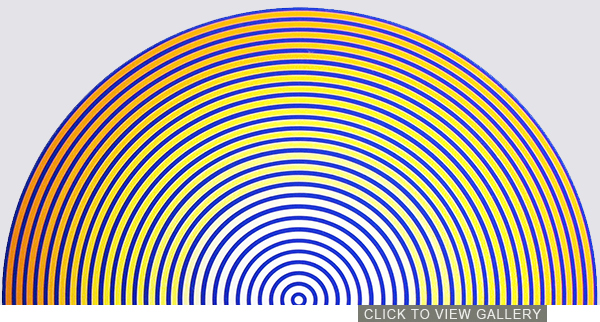
Becoming: Illuminating Experiences
The artwork of the Becoming: Illuminating experiences exhibition, curated by Clove Ellis, examines the struggles and triumphs of “becoming” as a queer, neurodivergent, inter-sectionally marginalized person. Navigate using the arrows to view the artwork, or click the image above to access the exhibit as a whole, along with a rich description.
eJournals at Wayne
-
Gender a Výzkum
 Publishes transdisciplinary research in the fields of feminism and gender studies, with a focus on Central and Eastern Europe.
Publishes transdisciplinary research in the fields of feminism and gender studies, with a focus on Central and Eastern Europe. -
Gender and Education
 Covers all aspects of education in relation to gender.
Covers all aspects of education in relation to gender. -
Gender and History
 Aims to create productive debates and dialogues across subfields, historiographies, and theoretical orientations with a focus on gender.
Aims to create productive debates and dialogues across subfields, historiographies, and theoretical orientations with a focus on gender. -
Gender and Society
 Focuses on the social and structural study of gender as a basic principal of the social order and as a primary social category, with emphasis on theory and research from micro and macrostructural perspectives.
Focuses on the social and structural study of gender as a basic principal of the social order and as a primary social category, with emphasis on theory and research from micro and macrostructural perspectives. -
Gender Forum
 Provides a forum for the discussion of gender-related topics in the fields of literary and cultural production, media and the arts as well as politics, the natural sciences, medicine, the law, religion and philosophy.
Provides a forum for the discussion of gender-related topics in the fields of literary and cultural production, media and the arts as well as politics, the natural sciences, medicine, the law, religion and philosophy. -
Gender IssuesPresents political, economic, social and behavioral analyses with diverse perspectives and policy conclusions.
Databases at Wayne
-
Defining Gender This link opens in a new windowDefining Gender provides access to a vast body of original British source material that will enrich the teaching and research experience of those studying history, literature, sociology and education from a gendered perspective.
-
Gender: Identity and Social Change This link opens in a new windowEssential primary sources documenting the changing representations and lived experiences of gender roles and relations from the nineteenth century to the present. This expansive collection offers sources for the study of women's suffrage, the feminist movement, the men’s movement, employment, education, the body, the family, and government and politics.
Gender Identity Through a Historical Lens
The Reverb Effect Podcast, University of Michigan: Season 2, Episode 2: The Unnatural Vice: King Henri III, Sodomy, and Modern Masculinity
From the producers:
The content of sodomy accusations has changed a lot over the past millennium. How does sexuality help forge conceptions of masculinity, both in sixteenth-century Europe and today?
How Ancient Mythologies Defy the Gender Binary | Fate & Fabled
A look into how some of the world's oldest stories present nuanced views on gender from cultures across the world.
-
The Origin of “Gender Identity”This article explores the various uses and origin of the term "gender identity" in the English language.
-
Viking warrior women? Reassessing Birka chamber grave Bj.581
 The warrior woman has long been part of the Viking image, with a pedigree that extends from the Valkyries of Old Norse prose and poetry to modern media entertainment. Until recently, however, actual Viking Age evidence for such individuals has been sparse. This article addresses research showing that the individual buried at Birka in an ‘archetypal’ high-status warrior grave—always assumed to be male since its excavation in 1878—is, in fact, biologically female.
The warrior woman has long been part of the Viking image, with a pedigree that extends from the Valkyries of Old Norse prose and poetry to modern media entertainment. Until recently, however, actual Viking Age evidence for such individuals has been sparse. This article addresses research showing that the individual buried at Birka in an ‘archetypal’ high-status warrior grave—always assumed to be male since its excavation in 1878—is, in fact, biologically female. -
Magic, Genderfluidity, and queer Vikings, ca. 750-1050
 From the Nazi Reich to the deadly storming of the U.S. Capital building on January 6, 2021, symbols of pre-Christian Norse religious practices, especially magic, have come to represent androcentricity, authoritarianism, and White nationalism. This modern misrepresentation contrasts how the Norse people themselves potentially saw these same signs and images: as subversive, subaltern, and queer.
From the Nazi Reich to the deadly storming of the U.S. Capital building on January 6, 2021, symbols of pre-Christian Norse religious practices, especially magic, have come to represent androcentricity, authoritarianism, and White nationalism. This modern misrepresentation contrasts how the Norse people themselves potentially saw these same signs and images: as subversive, subaltern, and queer. -
‘Girls, Don’t Talk Slang!’: late-Victorian verbal hygiene and contested gender rolesLate-nineteenth-century efforts to discourage women and girls from using slang constitute a classic example of what Deborah Cameron terms ‘verbal hygiene’ or ‘the urge to meddle in matters of language’. Using excerpts from a variety of conduct books, etiquette manuals, and opinion pieces published in the United States between 1868 and 1900, this article will investigate the relationship between this practice of verbal hygiene and a broader cultural anxiety over challenges to traditional gender norms during this period.
-
Gender in Modern East Asia by
ISBN: 9780813348766Publication Date: 2016-03-08Gender in Modern East Asia explores the history of women and gender in China, Korea, and Japan from the seventeenth century to the present. This unique volume treats the three countries separately within each time period while also placing them in global and regional contexts. -
Transgender History by
ISBN: 9780786741366Publication Date: 2009-01-07Covering American transgender history from the mid-twentieth century to today, Transgender History takes a chronological approach to the subject of transgender history, with each chapter covering major movements, writings, and events. -
Gender Shifts in the History of English by
ISBN: 9780511486913Publication Date: 2009-09-22How and why did grammatical gender, found in Old English and in other Germanic languages, gradually disappear from English and get replaced by a system where the gender of nouns and the use of personal pronouns depend on the natural gender of the referent? How is this shift related to 'irregular agreement' (such as she for ships) and 'sexist' language use (such as generic he) in Modern English, and how is the language continuing to evolve in these respects? -
Gender and the ''Natural' Environment in the Middle Ages by
ISBN: 9781837720576Publication Date: 2023-11-27A collection of essays that explore how humans understood their relationship with the environment in the Middle Ages. Using written and visual evidence from c.1150-1500 CE--including medical, literary, and scientific works--the essays in this collection address the relationship between the human and the "natural" at a time when new worlds, new texts, and new religious experiences reshaped the individual and collective relationship with the cosmos. -
 Embodying Peripheries
by
ISBN: 9788855186612Publication Date: Florence, 2022Note the chapter "Femminielli and the City". This book combines approaches from the design disciplines, humanities, and social sciences to foster interdisciplinary engagement across geographies around the identities embodied in and of peripheries.
Embodying Peripheries
by
ISBN: 9788855186612Publication Date: Florence, 2022Note the chapter "Femminielli and the City". This book combines approaches from the design disciplines, humanities, and social sciences to foster interdisciplinary engagement across geographies around the identities embodied in and of peripheries.
Wayne State University Press

Wayne State University Press holds both books and journals that deal with gender as a subject, and a list of books under the social science/gender studies category can be found here. Note that these books are for sale. You might also be interested in their series "Queer Screens" that collects a number of books on queer film studies, which can be found here.
Wayne State University Press is a distinctive urban publisher committed to supporting the core research, teaching, and service mission of WSU by generating high-quality scholarly and general-interest books of global importance. Through its publishing program, the Press disseminates research, advances education, and serves the local community while expanding the international reputation of the Press and the University.
Wayne State Digital Collections LGBT Detroit
Containing over 50,000 digitized items from the collections of the Wayne State University Library Systems, Wayne State Digital Collections can be accessed throught the Wayne State University Library System website at library.wayne.edu, navigating to resources at the bottom of the page, and selecting "Digital Collections". This guide specifically highlights the records of LGBT Detroit, which started as Kick Publishing Company in 1994. It was the third Black American LGBT media company in the U.S. They published nationally and provided information, awareness, and an avenue for organization in the LGBT community. In 2003, Kick Publishing Company became the nonprofit KICK- The Agency for LGBT African Americans, which became LGBT Detroit in 2015. They now focus on education and advocacy for the LGBT community in Detroit. Navigate to the collection via the hyperlink below.
Personal Experiences of Gender
Listen to the audio above, or read in text here: https://www.npr.org/2023/06/07/1180437210/elliot-page-pageboy-memoir
-
Out of the Ordinary by
ISBN: 9780823274802Publication Date: 2016-11-01The memoir of Michael Dillon/Lobzang Jivaka (1915-62), the British doctor and Buddhist monastic novice chiefly known to scholars of sex, gender, and sexuality for his pioneering transition from female to male between 1939 and 1949, and for his groundbreaking 1946 book Self: A Study in Ethics and Endocrinology. Here at last is Dillon/Jivaka's extraordinary life story told in his own words. -
Self-Made Woman by
ISBN: 9780299313906Publication Date: 2017-08-22Denise Chanterelle DuBois’s transformation into a woman wasn’t easy. Born as a boy into a working-class Polish American Milwaukee family, she faced daunting hurdles: a domineering father, a gritty 1960s neighborhood with no understanding of gender nonconformity, trouble in school, and a childhood so haunted by deprivation that neckbone soup was a staple. Terrified of revealing her inner self, DuBois lurched through alcoholism, drug dealing and addiction, car crashes, dangerous sex, and prison time. Dennis barreled from Wisconsin to California, Oregon, Canada, Costa Rica, New York, Bangkok, and Hawaii on a joyless ride. Defying all expectations, DuBois didn’t crash and burn. Embracing her identity as a woman, she remade herself. Writing with resolute honesty and humor, she confronts both her past and her present to tell an American story of self-discovery. -
Uncomfortable Labels by
ISBN: 9781785925870Publication Date: 2019-07-18'So while the assumption when I was born was that I was or would grow up to be a neurotypical heterosexual boy, that whole idea didn't really pan out long term.'In this candid, first-of-its-kind memoir, Laura Kate Dale recounts what life is like growing up as a gay trans woman on the autism spectrum. -
Transitioning Together by
ISBN: 9781785921032Publication Date: 2017-02-21This is the story of a long-lasting relationship, surviving against the odds. It is the story of Wenn and Beatrice Lawson, born almost twelve years apart in different countries with different cultures, who were both assigned female at birth. After nineteen years of marriage and four children, Wenn entered a same-sex relationship with Beatrice. Little did Beatrice know that twenty-two years later, Wenn would transition from female to male. This unique and honest memoir tells the story of Wenn's transition and Beatrice's journey alongside him. Co-written by Wenn and Beatrice, who are both on the autism spectrum.
-
The New York Times: Transgender Lives: Your StoriesA collection of the personal stories of transgender people hosted online by the NY Times.
Recent Journal Articles and Scholarly Research
-
Transgender Youth's Disclosure of Gender Identity to Providers Outside of Specialized Gender Centers
 The objectives of this study were to (1) determine the prevalence of voluntary disclosure and intentional avoidance to HCPs outside of gender clinics, (2) identify factors associated with voluntary disclosure and intentional avoidance, and (3) elucidate strategies to increase comfort with disclosure.
The objectives of this study were to (1) determine the prevalence of voluntary disclosure and intentional avoidance to HCPs outside of gender clinics, (2) identify factors associated with voluntary disclosure and intentional avoidance, and (3) elucidate strategies to increase comfort with disclosure. -
Gender Identity Disparities in Criminal Victimization: National Crime Victimization Survey, 2017–2018
 The objectives of this study were to estimate the prevalence of personal and household victimizations among transgender people in the United States.
The objectives of this study were to estimate the prevalence of personal and household victimizations among transgender people in the United States. -
“I Don’t Want to be a Girl. I Am a Girl!” Experiences Before, During and After Transition in Families with Trans Children and AdolescentsAbsract: Families often have little knowledge and skills to support their trans children. Therefore, our aim was to learn more about the experiences of parents of trans children and adolescents and how the transition process is experienced. Using a qualitative approach, we analyzed 22 life stories written by parents of trans children and adolescents. The data were analyzed with MAXQDA. Three key periods were considered: (1) before, (2) during, and (3) after social transition.
-
Trans Erasure, Intersex Manipulation: The First Amendment and Other Reflections From Women in Struggle v. Bain.
 Abstract: This Article breaks new ground with its proposal that litigators should consider the First Amendment to combat the avalanche of state legislation stripping transgender, gender nonconforming, intersex, and queer ("TGNCI") people of their rights. In the last year, opinions from the U.S. Federal Courts of Appeals for the Sixth and Eleventh Circuits have used lawsuits challenging anti-TGNCI legislation to roll back decades of progress made under the Equal Protection Clause for transgender people. This Article answers the question of where litigators should turn next and suggests that anti-TGNCI legislation is a form of First Amendment viewpoint discrimination.
Abstract: This Article breaks new ground with its proposal that litigators should consider the First Amendment to combat the avalanche of state legislation stripping transgender, gender nonconforming, intersex, and queer ("TGNCI") people of their rights. In the last year, opinions from the U.S. Federal Courts of Appeals for the Sixth and Eleventh Circuits have used lawsuits challenging anti-TGNCI legislation to roll back decades of progress made under the Equal Protection Clause for transgender people. This Article answers the question of where litigators should turn next and suggests that anti-TGNCI legislation is a form of First Amendment viewpoint discrimination.













